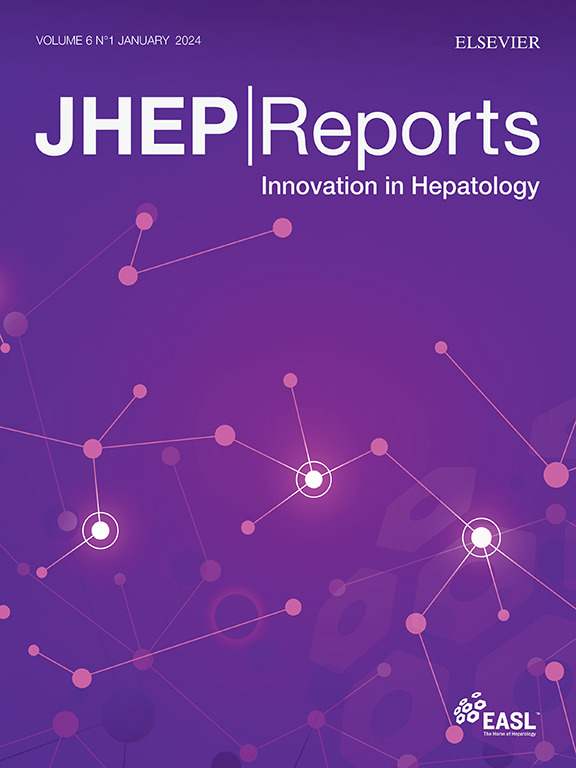The association between childhood obesity and major adverse liver outcomes in adolescence and young adulthood
IF 9.5
1区 医学
Q1 GASTROENTEROLOGY & HEPATOLOGY
引用次数: 0
Abstract
Background & Aims
Paediatric obesity is associated with liver steatosis and injury. We aimed to investigate the association between paediatric obesity and the risk of major adverse liver outcomes (MALOs) during adolescence and adulthood.
Methods
A cohort study of children with overweight or obesity enrolled in the Swedish Childhood Obesity Treatment Register (1997–2020) was performed (n = 29,321). Controls from the general population matched by sex, birth year, and resident areas were obtained (n = 141,510). The individuals were followed from age 10 (or obesity treatment initiation) up to age 40. MALOs were defined as any occurrence of cirrhosis, hepatocellular carcinoma, oesophageal or gastric varices, portal hypertension, liver transplantation, ascites, liver failure, or liver-related mortality.
Results
During a median follow-up of 8.3 [Q1–Q3: 5.5–11.8] years, MALOs were identified in 77 individuals. The cumulative incidence of MALOs by age 40 was 1.14% in the obesity cohort and 0.52% in the control group. Childhood adiposity was associated with the risk of MALOs (hazard ratio 2.15, 95% CI 1.33–3.48, p = 0.002). Individuals who had childhood obesity and developed alcohol use disorder during follow-up had an even higher risk of MALOs than controls without alcohol use disorder (hazard ratio 7.64, 95% CI 2.73–21.47, p <0.001). Type 2 diabetes did not mediate the association between childhood obesity and MALOs (p = 0.54).
Conclusions
Paediatric obesity is associated with a two-fold increased risk of MALOs. However, the absolute risk of developing MALOs by age 40 remains low.
Impact and implications
Firstly, healthcare providers should recognise that the consequences of paediatric obesity are not limited to immediate health concerns but rather present a sustained consequence on liver health into adulthood. Secondly, our findings revealed that a substantial proportion of individuals with alcohol use disorder experienced onset during adolescence, significantly amplifying the risk of major adverse liver outcomes. This underscores the importance of incorporating routine assessment for alcohol use disorder within paediatric care, particularly during adolescence, to identify and mitigate this increased risk. Thirdly, while the incidence of major adverse liver outcomes up to age 40 remains low, we identify a population at increased risk. This could help to refine risk stratification and target interventions more effectively.
儿童肥胖与青春期和青年期主要不良肝脏结局之间的关系
背景,目的:儿童肥胖与肝脂肪变性和肝损伤相关。我们的目的是调查儿童肥胖与青春期和成年期主要不良肝脏结局(MALOs)风险之间的关系。方法对在瑞典儿童肥胖治疗登记(1997-2020)登记的超重或肥胖儿童进行队列研究(n = 29,321)。对照来自按性别、出生年份和居住地区匹配的普通人群(n = 141,510)。这些人从10岁(或肥胖治疗开始)一直被跟踪到40岁。MALOs被定义为肝硬化、肝细胞癌、食管或胃静脉曲张、门脉高压、肝移植、腹水、肝功能衰竭或肝脏相关死亡的任何发生。结果在8.3年[Q1-Q3: 5.5-11.8]年的中位随访期间,77例患者发现malo。40岁时,肥胖组malo的累积发病率为1.14%,对照组为0.52%。儿童期肥胖与malo风险相关(风险比2.15,95% CI 1.33-3.48, p = 0.002)。在随访期间,儿童期肥胖和出现酒精使用障碍的个体比没有酒精使用障碍的对照组发生malo的风险更高(风险比7.64,95% CI 2.73-21.47, p <0.001)。2型糖尿病没有介导儿童肥胖和MALOs之间的关联(p = 0.54)。结论儿童肥胖与MALOs风险增加两倍相关。然而,到40岁时发生malo的绝对风险仍然很低。影响和启示首先,医疗保健提供者应该认识到,儿童肥胖的后果不仅限于直接的健康问题,而且对成年后的肝脏健康有持续的影响。其次,我们的研究结果显示,相当大比例的酒精使用障碍患者在青春期发病,这大大增加了主要不良肝脏结局的风险。这强调了将酒精使用障碍的常规评估纳入儿科护理的重要性,特别是在青春期,以确定和减轻这种增加的风险。第三,虽然40岁以下主要不良肝脏结果的发生率仍然很低,但我们确定了风险增加的人群。这可能有助于改进风险分层和更有效地进行有针对性的干预。
本文章由计算机程序翻译,如有差异,请以英文原文为准。
求助全文
约1分钟内获得全文
求助全文
来源期刊

JHEP Reports
GASTROENTEROLOGY & HEPATOLOGY-
CiteScore
12.40
自引率
2.40%
发文量
161
审稿时长
36 days
期刊介绍:
JHEP Reports is an open access journal that is affiliated with the European Association for the Study of the Liver (EASL). It serves as a companion journal to the highly respected Journal of Hepatology.
The primary objective of JHEP Reports is to publish original papers and reviews that contribute to the advancement of knowledge in the field of liver diseases. The journal covers a wide range of topics, including basic, translational, and clinical research. It also focuses on global issues in hepatology, with particular emphasis on areas such as clinical trials, novel diagnostics, precision medicine and therapeutics, cancer research, cellular and molecular studies, artificial intelligence, microbiome research, epidemiology, and cutting-edge technologies.
In summary, JHEP Reports is dedicated to promoting scientific discoveries and innovations in liver diseases through the publication of high-quality research papers and reviews covering various aspects of hepatology.
 求助内容:
求助内容: 应助结果提醒方式:
应助结果提醒方式:


